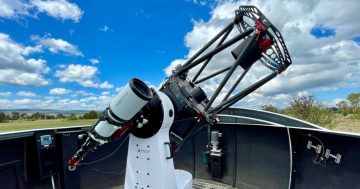
The Canberra Deep Space Communication Complex is playing a significant role in NASA Perseverance rover mission which lands on Mars this week. Photo: Alex Cherney (CSIRO).
It’s commonly known as the ‘seven minutes of terror’ when entering the atmosphere of Mars, but the team at CSIRO’s Canberra Deep Space Communication Complex will have a further frightful four minutes before they know if NASA’s Perseverance rover makes its much-anticipated landing on Mars this Friday at 7:55 am.
It takes 11 minutes and 22 seconds for communication from the rover to reach Earth, so the team of 85 engineers and technicians at the Tidbinbilla station will be hanging on to every little bit of data as the rover lands in a crater on the red planet.
“Canberra takes over operations an hour after landing and as early checkouts and surface operations for the rover begin, we’ll also be receiving data relayed through NASA’s orbiting spacecraft around Mars,” said Canberra Deep Space Communication Complex outreach manager Glen Nagle.
“Our CSIRO team have been a part of Perseverance’s mission since its launch in July 2020. We’ve maintained daily contact with the spacecraft on its eight-month journey to the red planet and will continue to support its exploration of Mars.”
Don’t be fooled: It may seem easy, but there’s nothing routine about landing on Mars. It all comes down to the final seven minutes…
Here’s how you can participate in the #CountdownToMars: https://t.co/lXnsgn7jaK pic.twitter.com/TejPovYUNQ
— ARCHIVED – NASA's Perseverance Mars Rover (@NASAPersevere) February 12, 2021
The Canberra team will again provide critical support for the mission that hopes to further unlock the secrets of Mars with a hefty dose of Australian ingenuity.
Coming in hot at 20,000 km/h, the Perseverance rover will land in a crater on Mars and lose line of sight with Earth.
“We’ll do what we call a bent-pipe relay and Canberra will be a key part of this process of getting data back, post landing,” Mr Nagle said.
“NASA wants to ensure we’ve got contact with the rover via its orbiter (another spacecraft in the orbit of Mars) to make sure Perseverance is all okay because it’s those first few hours after landing that is crucial to make sure the spacecraft is in good health.”

The sequence of events that occur in the final minutes of NASA’s Perseverance mission to Mars. Photo: NASA/JPL-Caltech.
The unmanned rover is in excellent hands, with all of the Canberra team playing a part in the mission to Mars.
“The rover has been very well behaved, but this week it will begin to wake up from the eight-month journey so we’ll be making sure there is no loss of contact,” Mr Nagle said.
“Some of our engineers and technicians have been here for 30 years and are the most dedicated people you would ever want to work with. They aren’t skills you learn at university.
“We always say that what we do is make the history that ends up in the textbooks.”
In gathering samples from Mars, Australian geologist and astrobiologist Dr Abigail Allwood is the lead scientist for an instrument on the rover’s robot arm called PIXL (Planetary Instrument for X-ray Lithochemistry)
It identifies chemical elements at a tiny scale and has a camera that takes super close-up pictures of rock and soil textures as small as a grain of salt. This may help scientists look for signs of past microbial life on Mars.
“It’s great to see Dr Allwood as well as our own engineers and technicians playing such a significant role in this exciting mission to search for life and taking the next steps in our human adventure to Mars,” Mr Nagle said.
NASA Associate Administrator for Communications Marc Etkind said landing on Mars is never easy.
“But as NASA’s fifth Mars rover, Perseverance has an extraordinary engineering pedigree and mission team. We are excited to invite the entire world to share this exciting event with us,” Mr Etkind said.
To learn more, or watch the landing live (plus 11 minutes and 22 seconds), visit Perseverance mission to Mars.
Original Article published by Michael Weaver on The RiotACT.








